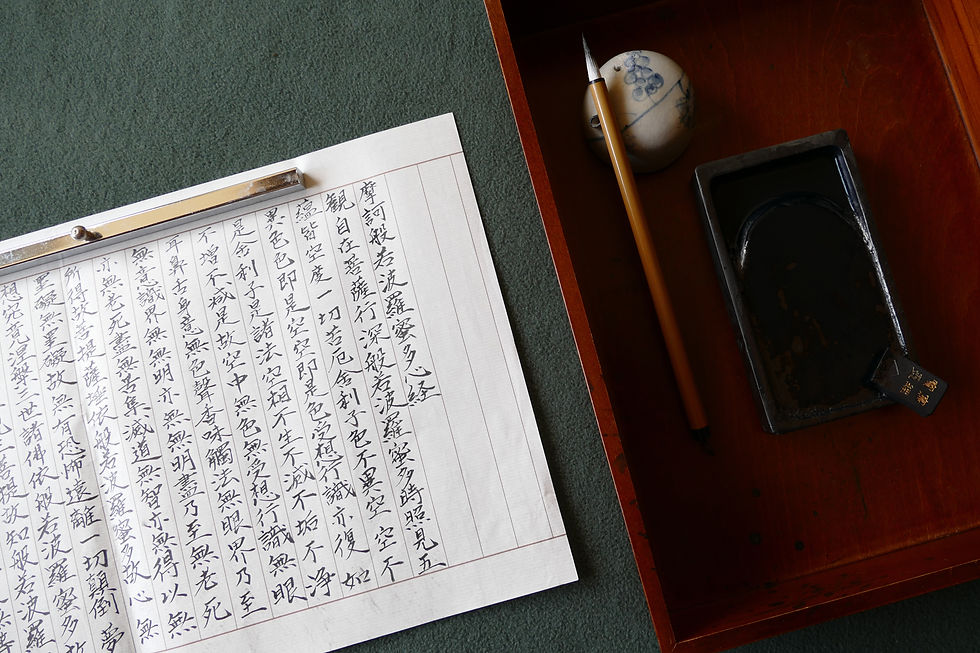The True Tools of Japanese Calligraphy Artists: Tradition, Craftsmanship, and Value
- 清水 芳樹
- 7月26日
- 読了時間: 3分

Why Tools Matter in Japanese Calligraphy
Japanese Calligraphy, or Shodo, is far more than just writing; it’s an artistic discipline, a meditative practice, and an embodiment of Japanese culture. For collectors, enthusiasts, and those with a genuine interest in Japanese tradition, understanding the real tools that professional calligraphy artists use is a gateway to experiencing a living cultural heritage. Today, authentic calligraphy tools are becoming a luxury collectible, appreciated not only by Japanese practitioners but also by global art lovers with refined taste.
1. Essential Calligraphy Tools: An Overview
The basic set consists of four elements: the brush (fude), ink (sumi), inkstone (suzuri), and Japanese paper (washi). Each has evolved over centuries, and the quality of each tool dramatically influences the final artwork. Entry-level sets might cost under $100, but professionals often invest thousands of dollars in their tools. What makes such a price difference?
2. The Calligraphy Brush: A Work of Art in Itself
The calligraphy brush is the “soul” of the Japanese artist. While cheap brushes for beginners are available for $5–$20, authentic Kumano or Nara brushes, handmade by master craftsmen, easily reach $200–$1,000 or more per piece. The most prestigious brushes use hair from weasel, goat, horse, or deer, each selected for its unique ink-carrying properties and resilience. Artisans in Hiroshima and Nara have refined the craft for centuries. For collectors, a signed brush by a renowned maker, used by a famous artist, can command prices in the tens of thousands of dollars—an object valued as much for its cultural lineage as for its function.
3. The Secret World of Ink: From Everyday Bottles to Vintage Masterpieces
While bottled ink (bokuju) is popular among hobbyists and students (usually $5–$20 per bottle), serious calligraphers prefer handmade solid inksticks. Here, prices start at $50 for mid-level sticks and can reach $1,000 or even $10,000 for aged or “vintage” sumi. What makes vintage ink so valuable? Over decades or even centuries, high-quality ink develops a smoother texture, richer color, and subtle fragrance. Some “antique” inksticks over 100 years old are considered national treasures, and wealthy collectors—especially from China and Hong Kong—have recently driven up global demand. For many, owning a piece of vintage Japanese sumi is akin to owning a bottle of rare wine.
4. Washi: The Unsung Hero Behind Masterpieces
Japanese paper, or washi, is renowned for its beauty, resilience, and unique texture. Machine-made washi for everyday use can be had for $1–$5 per sheet. Yet, hand-made washi from regions such as Echizen or Mino can cost $30–$100 per sheet, or more. Authentic washi absorbs ink differently, lending depth and subtlety to each brushstroke. For high-profile exhibitions and international art sales, only the finest hand-crafted washi is acceptable. In recent years, diminishing numbers of traditional papermakers have made high-end washi even more valuable.
5. Collecting and Investing in Calligraphy Tools
For serious practitioners and collectors alike, assembling a set of authentic Japanese calligraphy tools is not just a matter of function—it’s a cultural investment. A beginner’s professional-level kit (brush, ink, inkstone, washi) might run $1,000–$3,000. Advanced collectors often seek historically significant or artist-used pieces, pushing total investments well beyond $10,000.Many reputable Japanese online shops now ship worldwide, catering to the growing number of non-Japanese collectors.
6. The Value of Authenticity: Stories and Lineages
Every handmade brush or inkstick has a story—of the craftsman, the region, the materials, and sometimes even the original artist. For connoisseurs, provenance is everything. In Japan, some brushes are treasured as family heirlooms, passed down for generations. In the West, the notion of owning “tools of tradition” is now associated with sophisticated taste, much like collecting fine art, watches, or rare musical instruments.
7. The Future of Japanese Calligraphy Tools: Global Demand and Cultural Appreciation
Interest in Japanese calligraphy tools is rising not just in Japan but worldwide, especially among high-income, culturally curious individuals. As traditional crafts face the threat of extinction due to aging artisans and declining local demand, the global collector market has become a key factor in sustaining these crafts for the future.
ConclusionTo own and use authentic Japanese calligraphy tools is to participate in an ongoing story of craft, culture, and creativity. Each brushstroke carries centuries of tradition, and every piece of washi or sumi connects you to a living history. For those seeking more than just decoration—for those who wish to invest in the true essence of Japanese culture—these tools are the ultimate treasures.
deepens your connection to Japanese tradition.Explore and purchase hand-selected Japanese calligraphy artworks:
Discover the stories, history, and unique meaning behind Japanese calligraphy:https://0108shimizu.wixsite.com/japanesecalligraphy



Comments